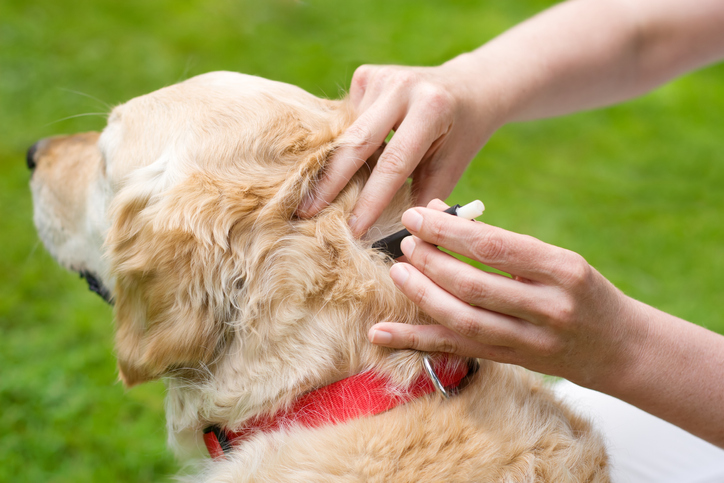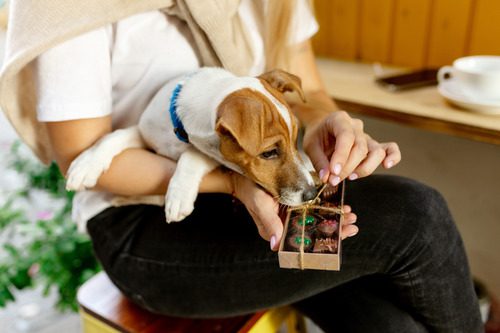How to Remove a Tick from Your Dog
Does your dog have a tick buried up under their skin? Or are you concerned that this could happen during one of the many outings with you? Ticks are a common problem for dogs, and since tickborne illness is a threat, it’s important to remove them quickly when they latch onto your pet.
In the article below, we’ll walk you through the steps you need to take to remove a tick from your dog. With the help of this guide, you can quickly and safely remove the tick, making sure to get the mouthparts as well, and keep your dog safe too.

Gather Your Supplies
First, gather all the supplies you’ll need before you let your dog know what’s going on. Your dog is likely to be nervous about the removal process, so it is better to have everything prepared before you bring them into the area.
Gather a clean pair of tweezers, a washcloth with soap and water already on it, and some rubbing alcohol or antibiotic ointment. Keep some treats handy for after the removal process and consider asking another family member to help you hold and support your dog during this experience as well.
Locate the Tick
Next, you’ll need to locate the tick. If your dog’s hair is very long or tightly curled, you may need to use clippers or scissors to cut a small patch away and provide better access to the location of the tick.
While finding the tick, you should also double-check how buried it really is. If it is only slightly latched onto the skin, removal will be easy. However, if it is already swelling and has been there for several days, removal may be more difficult.
Carefully Place the Tweezers
With the tick located (and your dog’s hair removed in the area, if needed) it’s time to place the tweezers. It is very important to place the tweezers parallel to the dog’s body, rather than at an angle or perpendicular to the skin. This way, you will make sure you get the whole tick in one movement.
Your dog may be uncomfortable when you place the tweezers, especially if the tick is already buried fully. Be sure to comfort them a lot during this step!
Note that you can purchase tick removal tools from pet stores if you’re having trouble working with tweezers.
Pull Straight Up
With the tick carefully grasped in the tweezers, pull straight up and away from the dog’s skin. You may need to apply some gentle pressure to the skin to pull against the movement of the tweezers, too. It is important to pull straight up, instead of diagonally away from the body, to prevent the mouthparts (the “head”) from breaking off of the tick and staying in the body.
If the mouthparts do break off, you may need to take your dog to the veterinarian to have them removed. However, if you have sharp enough tweezers and someone to help hold your dog, you may be able to remove them yourself.
Clean and Disinfect
With the complete tick removed from the dog’s skin, it’s time to clean and disinfect the wound. First, wash it gently with the soapy washcloth you have prepared already. After that, disinfect it with a little bit of rubbing alcohol or with an antibiotic ointment. If the wound is particularly unpleasant, you may want to use both.
This process is important because it prevents the bite from becoming infected. However, you will still need to watch your dog for signs of tickborne illness in the coming days.
Praise and Treats
With everything finished and cleaned up, it’s time to give your dog lots of praise and treats for being so patient with you! Tick removal is uncomfortable for humans, but it is especially difficult for dogs, who do not fully understand why they’re hurting during the experience. Make sure your dog knows they are okay now and that you’re happy with their behavior.
If your dog is very upset and you can’t seem to remove the tick, even with the help of another family member, it may be time to see a veterinarian. Although it may seem a little counterproductive to take your dog to the vet just to have a tick removed, it is sometimes the only option for very nervous pets.
Heart + Paw Can Help with Tick Removal
By following the guide above, you should be able to carefully remove a tick from your dog before it becomes a serious problem. If you are unsure of your ability to do this, however, you may want to take your dog to Heart + Paw for assistance. Visit our locations page to find the nearest location or book an appointment online.
If you live in a location where Lyme disease is extremely common, consider saving the tick in a plastic baggie and taking it to the vet to be checked. The vet can tell you whether this particular type of tick is a threat to your dog’s health.
Recent Posts
Can Dogs Eat Ham?
Ham is a popular meat found on many dinner tables, especially during the holidays. As a dog…
8 Signs and Symptoms of Diabetes in Dogs
Caring for a dog means being tuned in to the subtle changes that can reveal their overall…
Why Dogs Can’t Eat Chocolate and Tips for Keeping This Sweet Treat Out of Their Reach
Chocolate is a beloved indulgence for us, but for our dogs, it’s a hidden danger that can…
Why Cat Teeth Cleaning is Important For Your Pet’s Health
As a cat owner, you know how important it is to care for your feline friend’s overall…
Cat Body Language: A Guide To Understand What Your Cat is Telling You
Imagine trying to communicate without words, relying solely on subtle gestures, glances, and movements. This is how…
About Us
Heart + Paw was founded in 2018 by Chief Veterinary Officer Dr. George Melillo, who currently serves the Mid-Atlantic area. Heart + Paw offers a combination of veterinary care, pet grooming, and dog daycare to help be a resource in your pet parenthood journey.
We'd Love to Meet Your Four-Legged Friends
Find out how the friendly veterinary team at your local Heart + Paw can help your pets live longer, healthier lives by searching for a location near you.





